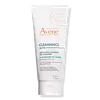What's inside
What's inside
 Key Ingredients
Key Ingredients

 Benefits
Benefits

 Concerns
Concerns

 Ingredients Side-by-side
Ingredients Side-by-side

Salicylic Acid
MaskingWater
Skin ConditioningSodium Cocoyl Isethionate
CleansingCocamidopropyl Hydroxysultaine
CleansingPropanediol
SolventStearyl Alcohol
EmollientCoco-Glucoside
CleansingSodium Lauroyl Sarcosinate
CleansingBetaine
HumectantGlyceryl Laurate
EmollientSodium Chloride
MaskingGlycerin
HumectantCetearyl Olivate
Hydroxypropyl Methylcellulose
Emulsion StabilisingSodium Benzoate
MaskingSaccharide Isomerate
HumectantSorbitan Olivate
EmulsifyingHydroxypropyl Guar Hydroxypropyltrimonium Chloride
Xanthan Gum
EmulsifyingTrisodium Ethylenediamine Disuccinate
Potassium Sorbate
PreservativeLactobacillus Ferment Lysate
Skin ConditioningCitric Acid
BufferingSodium Citrate
BufferingAcrylates Copolymer
Salicylic Acid, Water, Sodium Cocoyl Isethionate, Cocamidopropyl Hydroxysultaine, Propanediol, Stearyl Alcohol, Coco-Glucoside, Sodium Lauroyl Sarcosinate, Betaine, Glyceryl Laurate, Sodium Chloride, Glycerin, Cetearyl Olivate, Hydroxypropyl Methylcellulose, Sodium Benzoate, Saccharide Isomerate, Sorbitan Olivate, Hydroxypropyl Guar Hydroxypropyltrimonium Chloride, Xanthan Gum, Trisodium Ethylenediamine Disuccinate, Potassium Sorbate, Lactobacillus Ferment Lysate, Citric Acid, Sodium Citrate, Acrylates Copolymer
Ingredients Explained
These ingredients are found in both products.
Ingredients higher up in an ingredient list are typically present in a larger amount.
Water. It's the most common cosmetic ingredient of all. You'll usually see it at the top of ingredient lists, meaning that it makes up the largest part of the product.
So why is it so popular? Water most often acts as a solvent - this means that it helps dissolve other ingredients into the formulation.
You'll also recognize water as that liquid we all need to stay alive. If you see this, drink a glass of water. Stay hydrated!
Learn more about Water